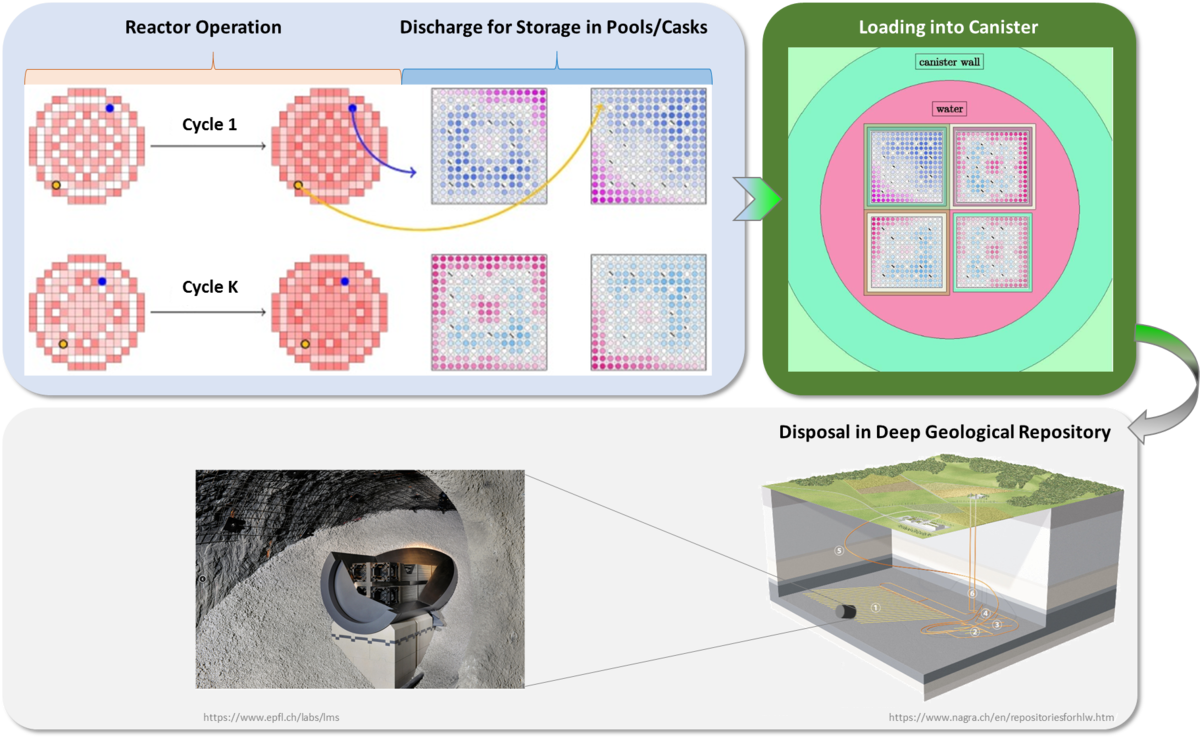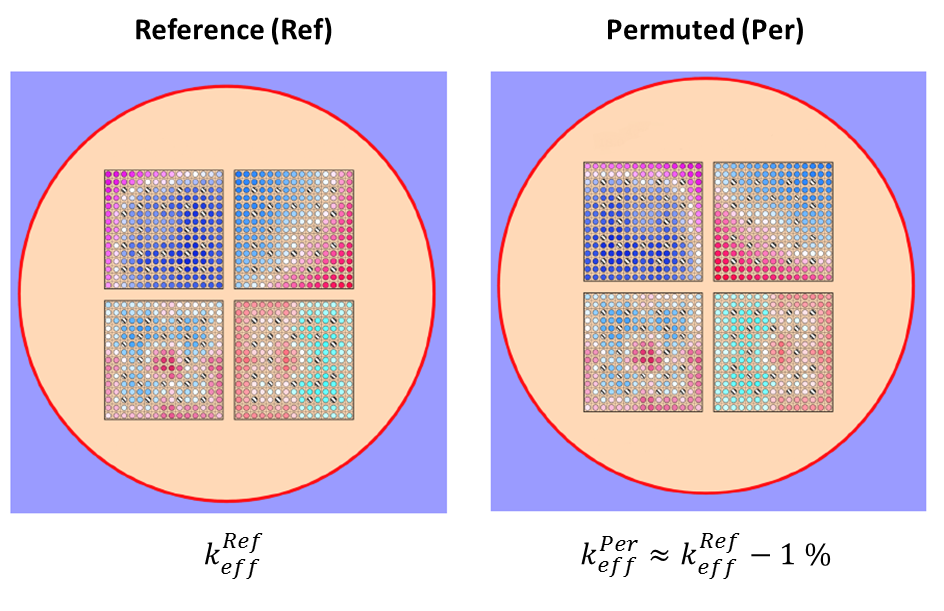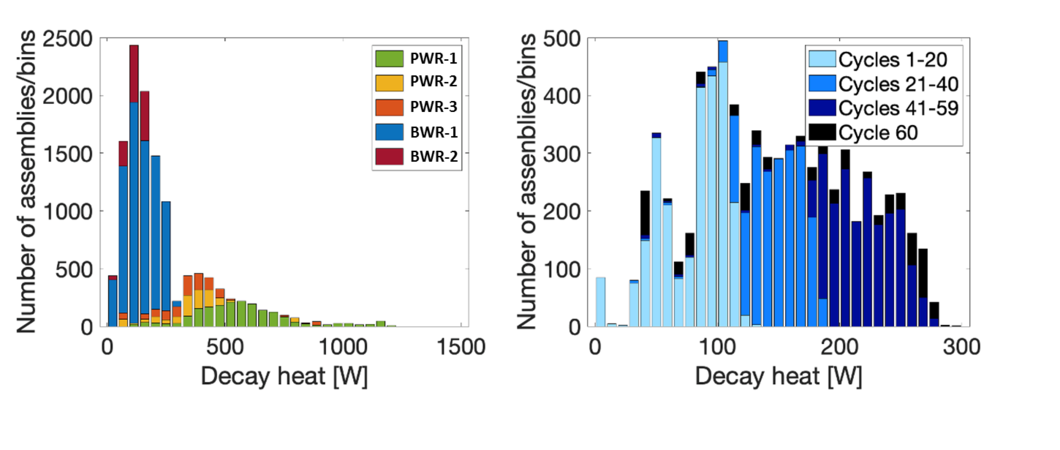Used Nuclear Fuel: from Better Characterization to Better Optimization
The safe and economical final disposal of Used Nuclear Fuel (UNF) in a deep geological repository is one of the highest priorities for the back-end of the fuel cycle in Switzerland. Once loaded into a disposal canister at an encapsulation facility and transferred thereafter underground (typically below 300 m), it has to be ensured that the canister will remain harmless to the environment at all times. The disposal is just the last step of a long and complex process for the management of UNFs. Each of these steps is not only subject to very strict safety requirements but also to a multiple range of technological, logistical, environmental and financial constraints. The latter includes costs for the encapsulation and repository facilities as well as for each of the canisters that will be needed to dispose all of the UNF volume. Evidently, all of this translates into a multi-objective optimization process of high dimensionality. To aboard such complex problem, the laboratory for reactor physics and thermal-hydraulics (LRT) is developing capabilities in various directions with canister optimization as main activity right now. In that context, the underlying approach is to advance simulation capabilities such as to provide higher-resolution higher fidelity characterizations of the UNF content for each single nuclear fuel rod ever operated in a Swiss reactor. This information is then combined with advanced optimization techniques in order to find new loading options for the canisters which fulfil all the imposed safety and design criteria while reducing at the same time, the number of required canisters. To better assess the feasibility as well as the potential of this approach, the optimization is at this stage focused only on two of the main safety and design criteria, namely criticality and decay heat as described next.
Criticality
One key aspect of the canister safety is to ensure sub-criticality (i.e. no self-sustained fission chain reaction) for the full duration of the long-term UNF disposal. This is summarized in a unique term for a given canister called keff, which must hence be proven to be below the sub-criticality limit (e.g. 0.95 when assuming an administrative margin of 5% and without account of additional margins). This keff, value depends on the UNF loaded into a canister (4 UNF are considered here in one canister). To compute it, the LRT methodology consists of three coupled computational steps: 1) statee-of-the-art reactor core simulations for all operated fuel assemblies with the in-house CMSYS platform (currently based on the CASMO/SIMULATE codes); 2) high resolution pin-resolved estimations of the UNF content (actinides and fission products) in each single fuel rod of each assembly and at any given post-discharge time (using currently the SNF code; 3) 3-D Monte-Carlo models of the filled canisters for the criticality calculations using e.g. the MCNP or Serpent codes.. With this scheme, referred to as CS2M (CMSYS/SNF to Monte-carlo), and when considering just 50 isotopes, the total number of material concentrations in the Monte Carlo model is in the vicinity of 1 million. For such calculation of a unique keff value, many hours are needed with an office desktop.
The complexity of the problem starts when considering that the keff is not the same depending on how the four assemblies are loaded: it depends on the assembly radial rotations, relative positions to each other, and on the axial rotations. As a simple example, the positioning of 4 UNF in a canister can be done in more than 93 000 manners, each one with a different keff. An example is presented in Fig.1.
In this example, the same 4 UNF are located differently in the canister. Colours are proportional to the actinide contents (blue: low concentration, red: high concentration). One can see that by using better information on the detailed rod wise isotopic contents, the calculated keff can be reduced by nearly 1% just by permuting the orientation of 3 out of 4 UNF assemblies. Considering that about 12 000 SNF will be loaded in canisters, the number of possibilities is simply tremendous. Therefore, an efficient optimization needs to be developed. In that perspective, a preliminary study was done by combining the high resolution UNF simulations with a neural network and apply this for a limited number of UNF and combinations. Such approach allowed to speed up the calculation of keff, from hours down to milliseconds with no significant loss of accuracy. For the future, a generalization of the neural network capabilities is needed for a larger family of UNFs. But this first study has already shown that such advanced optimization techniques can be practically realised with high enough accuracy, providing thereby confidence that the range of optimization options for disposal canisters could be subtntial enlarged.
Decay Heat
The optimization of the number of canisters must also be tackled with consideration of the decay heat. From a design point of view, the canister outer wall temperature needs to be limited in order to minimize the heat to the surrounding engineering and geological barriers. Given a specific canister design, the temperature is linked to the canister heat output which is equivalent to the total decay heat from the 4 UNF assemblies. Although the decay heat will gradually decrease with time due to the natural radioactive decay processes, limiting the canister wall temperature will hence require to limit the decay heat. Compared to keff, the canister heat output is “simpler” to calculate as it is simply the linear sum of the individual UNF assembly decay heat values and this sum does not depend on the UNF locations and/or orientations inside the canister. Given that the CS2M scheme also provides the UNF decay heat, a database of decay heat can then be constructed for the complete stockpile of operated fuel assemblies at end of lifetime of a given reactor. As pilot study, a Swiss analysis was conducted assuming a total of 12 000 UNF assemblies after end of operation of all reactors. To this aim, representative models were applied for the few past operated cycles for which detailed information is not yet available as well as for future cycles. In addition, a given capacity for the planned encapsulation facility was assumed using information that was at hand. An example for the assembly decay heat from the five Swiss cores is presented in Fig.2.
Given the UNF decay heat, the filling of canisters with a given number of assemblies can be done in an infinite number of solutions. The goal is thus to find the solutions that allow to maximize the canister filling while keeping the heat output of all canisters below the required limit. To perform this work, a genetic algorithm was developed and applied using as basis, the database of UNF assembly decay heats shown in Fig. 2 and taking into account changes as function of cooling time. Through this approach, optimization solutions were found that would allow loading the BWR UNFs in the theoretical minimum number of canisters (i.e. almost all canisters filled without empty location, leading to a filling fraction of 99.9%). For PWRs, a filling fraction close to 90 % was achieved. These pilot analyses provide thus confidence in continuing the research on combining high resolution UNF simulations with advanced optimization techniques and to enlarge this approach with account of a larger number of safety and design requirements as well as a larger number of technological, logistical and environmental related constraints. As part of this, refinements of assumptions made so far will also be aimed at along with the assessment of different algorithms and optimization methods.


